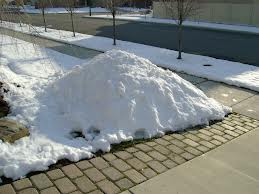Unusually large amounts of snow and a late winter thaw can spell trouble for home lawns in VT and NH. Massive piles of snow and ancient icy banks are determined to persist well into late April. Slow melting ice and snow is anything but good news for grass buried deep beneath the arctic wasteland we call home as temperatures remain far below average in the last days of March. The real damage from the copious use of rock salt will become apparent as the snow recedes, exposing brown and yellow patches along walkways and driveways. Pieces of turf now flipped upside down lie like fish out of water from plow damage after each successive storm in what has been called a “real winter”. Cue the spotlight on snow mold as the cold temperatures, with just the right amount of humidity, are ideal for this disease to thrive. Pink and gray snow mold may be widespread and hamper the ability of your lawn to recover successfully from the trauma dealt by Mother Nature. If I had a batman lamp, I would surely turn it on and point it into the night sky; our lawns need help.
Fear not, Mr. Grass is here and although not a super hero, I am well versed in the green art of lawn care and helping the innocent lawns which have been beaten down from a harsh winter. You can help your lawn immediately by breaking up piles of ice and snow, scattering the chunks onto warmer surfaces to melt; a driveway or patio perhaps. The faster the snow goes, the quicker the soil will warm and awaken your dormant lawn into recovery mode. If there are excessive leaves, debris, branches and other objects, try and remove them before the lawn begins growing to prevent mulching and unnecessary damage. This is especially true of gravel and rocks that may have been pushed up and onto lawn surfaces from winter plowing. Rake and remove any gravel and sand from your lawn. If you do have visible turf chunks, help them by flipping the root surface over and put it back on the ground so when growth occurs, some root regeneration can occur. Leaving chunks of lawn in pieces lying on each other will also damage the healthy lawn below; acting as mulch. This phenomenon is especially true as things really warm up and the grass begins to grow again.
 Additional winter recovery can be obtained by firing up the friendly soil micro-organisms with compost tea, a high quality lime, or fertilizers. I do not recommend heavy dethatching because the damage inflicted may well thin out or even kill portions of your lawn under such stress. I do recommend lightly raking out any matted snow mold and ice damage which will speed up the drying process, warm the soil, and promote new root and shoot growth. Your lawn will need extra help this spring so plan on doing your part. As your lawn recovers, using crabgrass or other broadleaf weed controls become more practical as tools to protect future infestations. Good luck and may the temperature rise in your neighborhood creating more green and less white!
Additional winter recovery can be obtained by firing up the friendly soil micro-organisms with compost tea, a high quality lime, or fertilizers. I do not recommend heavy dethatching because the damage inflicted may well thin out or even kill portions of your lawn under such stress. I do recommend lightly raking out any matted snow mold and ice damage which will speed up the drying process, warm the soil, and promote new root and shoot growth. Your lawn will need extra help this spring so plan on doing your part. As your lawn recovers, using crabgrass or other broadleaf weed controls become more practical as tools to protect future infestations. Good luck and may the temperature rise in your neighborhood creating more green and less white!


